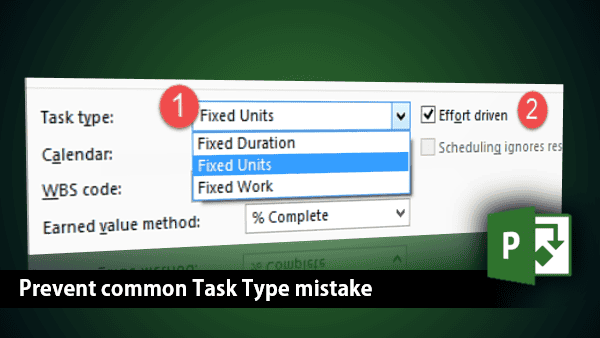Using Microsoft Project Fixed Duration/Work/Unit Type Fields

Many users have questions about Microsoft Project fixed work vs fixed duration fields. This lesson focuses on the project planning phase and using the different task types to build an accurate work breakdown structure. After the project manager and other stakeholders understand the project scope, the project can be decomposed into manageable chunks and individual tasks with time estimates.
Estimates are predictions of task effort and duration. Microsoft Project supports different task types, including Fixed Duration, Fixed Work, and Fixed Unit types.
Understanding these project types and how they interact with MS-Project is essential. It is recommended that a project plan be created with a mix of fixed-work and fixed-duration tasks. The MS-Project Type field allows the project manager to create a well-defined project plan with status meetings and reviews built into the project schedule. The plan becomes a more accurate representation of project execution.
A typical project includes effort-driven and duration-driven tasks. A project manager may include duration task types such as milestone reviews after each lifecycle phase. Since these milestones depend on the work in each phase, it is helpful to include them in the plan to organize and communicate project status.
These meetings are added to the project plan with a Fixed-Duration task type. Any team status meeting, project milestone review, or code review meeting is a fixed-duration task. A one-hour team status meeting has a fixed duration regardless of the number of resources attending the meeting. The amount of work will fluctuate depending on the number of attendees.
Writing a project charter document, coding a software program, or building a detailed project plan are fixed work tasks. The Fixed Work task type is useful when team members provide estimates by task. For example, a task to develop a report is estimated at 40 hours with one team member assigned. The amount of work is fixed at 40 hours, and the duration changes depending on the team members’ availability. The report should be completed in five days if the team member is available 100 percent of the workweek.
The Microsoft Project Formula
MS-Project uses the formula to calculate duration, resources (units), and effort.
Duration X Units = Work
MS-Project expects the user to provide two inputs and calculates the third. To view these fields and the impact of task types, additional fields need to be added to the Task Entry View.
To create a Fixed Duration task:
- Insert the Type field in the Gantt Chart view
- Enter the task name
- Change the Type field to Fixed Duration
- Enter the Duration
- Enter the Resources
- MS-Project will calculate the effort
To create a Fixed Work task:
- Insert the Type field into the Gantt Chart view
- Enter the task name
- Change the Type field to Fixed Work
- Enter the Effort in the Work field
- Enter the Resources
- MS-Project will calculate the duration
A helpful reminder in the Duration X Units = Work is to pick two variables (duration, units, or work) and let Microsoft Project calculate the result. Remembering this tip will help you avoid resource overallocation frustration as the variables change as you enter a resource allocation of 100% and then try to adjust both duration and work. Experiment with these task types to understand the relationship duration, units, and work share in MS-Project. Including these task types in the plan will develop a more realistic plan that reflects actual execution and gain better control over critical dates and milestones.


